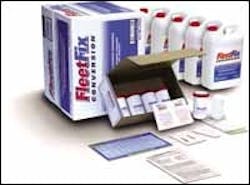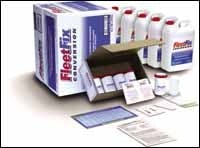Change to Extended-Life Coolant with No Flush and Fill
Many manufacturers ship heavy equipment with radiators full of extended-life coolant (ELC), which presents a major maintenance challenge to buyers whose fleets include radiators full of conventional coolant. ELC is popular because it lasts up to 600,000 miles or 12,000 hours, and requires an additive booster only once, halfway through its life. But diluting ELC chemistry just 20 percent with conventional coolant or water ruins its extended-life properties, and it must be maintained like a conventional coolant.
ChevronTexaco's FleetFix Conversion Pack is designed to convert conventional cooling systems to ELC without having to drain, flush and refill radiators. Conversion Packs include a concentrated version of the inhibitors found in ChevronTexaco ELC. It's mixed at a ratio of one gallon for every nine to 12 gallons of coolant being converted. Kits also include test strips, radiator ID stickers, post-conversion coolant test kits, and a complete set of conversion instructions with freeze-point charts.
Converting takes four steps.
First, draw a sample and test it with a refractometer to establish the system's freeze point, or glycol concentration. If the freeze point is high (greater than 0 degrees), ChevronTexaco recommends flushing the system and refilling with new coolant.
Dip a test strip to check nitrite and pH levels. If nitrite is high or pH is below 7.5, drain and flush the system and start over with new coolant.
"Our goal is not to add an expensive inhibitor concentrate to a cooling system that's not ready for it," says Carmen Ulabarro, coolant-marketing specialist with ChevronTexaco. "You want a cooling system that's in good enough condition to accept an inhibitor concentrate and reliably protect the engine for the life of the coolant."
Add conversion concentrate to an active flow line or directly into the radiator. Circulate the coolant thoroughly and mail a sample to ChevronTexaco. Analysis is included in the program cost, and it ensures that the additive is at the correct level for proper protection.
The best way to convert old systems to ELC is to drain, flush and fill the radiator with new, premixed coolant. But the time it takes to do that and cost of disposing of the old coolant prevents most fleet managers from considering the change. That's why ChevronTexaco developed FleetFix.
The company has about 10 years of experience, converting more than 150,000 vehicles. Ulabarro says the FleetFix solution has proven safe and reliable.
The entire process takes approximately an hour to an hour and a half, and can be done in the field. ChevronTexaco estimates that the cost is about 60 percent of a drain/flush/fill conversion.


